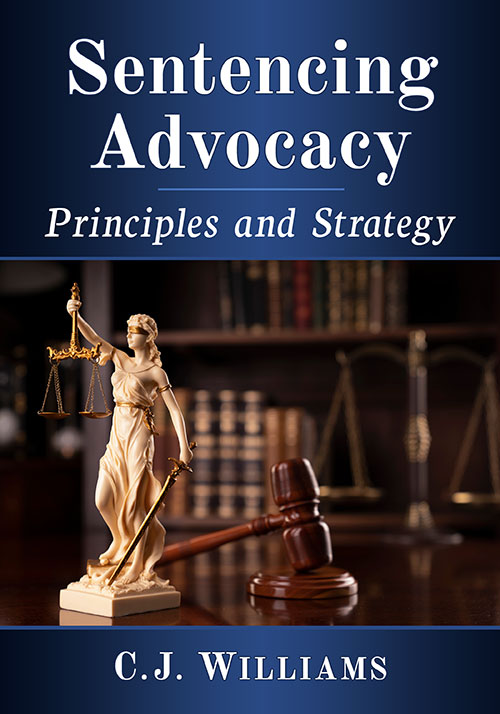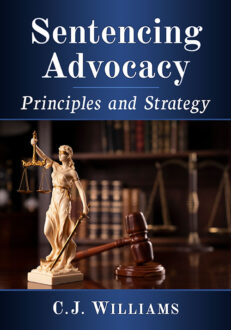Sentencing Advocacy
Principles and Strategy
$55.00
In stock
About the Book
To ensure a fair criminal trial, effective sentencing advocacy is needed in every stage of prosecution, from investigation through plea, trial and sentencing hearings. With fewer criminal cases proceeding to trial, advocacy is increasingly critical for both prosecutors and defense attorneys and can determine whether or not a defendant receives an appropriate sentence.
Here is a volume that comprehensively describes the steps to effective sentencing advocacy, addressing not only terms of imprisonment or probation, but fines, forfeiture, restitution and other collateral sentencing consequences. It emphasizes approaching sentencing advocacy holistically, treating it as a key component of attorney advocacy in every criminal case. Covering the fundamental sentencing procedures and concepts, it describes where and how attorneys can use advocacy to advance their clients’ goals. It also explains aspects of sentencing that otherwise may appear too complex to a novice criminal practitioner. Importantly, this is not a book on sentencing law, although it addresses legal sentencing issues as they pertain to sentencing advocacy. Rather, the focus is on teaching attorneys how to use advocacy to achieve the best sentence for their clients.
About the Author(s)
Bibliographic Details
Hon. C.J. Williams
Format: softcover (7 x 10)
Pages: 301
Bibliographic Info: notes, bibliography, index
Copyright Date: 2023
pISBN: 978-1-4766-8754-4
eISBN: 978-1-4766-4747-0
Imprint: McFarland
Table of Contents
Acknowledgments vi
Preface 1
1. The Importance of Effective Sentencing Advocacy 3
2. Principles of Judicial Advocacy 8
A. Differences in Context 9
B. The Decision-Maker 12
C. Practical Advice for Effective Judicial Advocacy in Sentencing 17
3. The Goals of Sentencing 21
4. Statutory and Guidelines Provisions 25
A. Indeterminate Sentencing, Determinate Sentencing, and Advisory Guidelines 25
B. The Interaction Between Statutory and Guidelines Provisions 31
C. Federal Statutory Sentencing Provisions 31
D. Federal Sentencing Guidelines Provisions 33
E. Burdens of Proof in Sentencing 38
F. Summary 39
5. Scope of a Criminal Sentence 40
6. Sentencing Advocacy Before Guilt Determination 45
A. Prosecution Investigations and Charging Decisions 45
B. Defense Investigations 47
C. Pretrial Detention or Release 49
D. Post-Offense, Presentence Conduct 51
E. Motions Practice 52
F. Plea Bargaining 53
G. Organizations 55
7. Stages in the Sentencing Process 58
8. Drafting of and Objecting to Presentence Investigation Reports 61
A. The Probation Officer’s Presentence Investigation 61
B. Drafting of the Presentence Investigation Report 64
C. Reviewing the Draft Presentence Report 68
D. Making Formal Objections to the Draft Presentence Report 72
E. Reviewing the Final Presentence Report 77
9. Sentencing Memoranda 78
A. Organization 79
B. Tone and Style 80
C. Legal Support 82
D. Requested Relief 82
E. Personal or Confidential Information 84
10. Preparing for Sentencing Hearings 85
A. Basic Preparation 85
B. Preparation When Offenders Have Pending Charges 87
C. Preparation for Factually-Contested Sentencing Hearings 89
D. Legal Arguments 99
E. Working with Crime Victims 100
11. Conducting Sentencing Hearings 102
A. Opening of Court and Initial Procedures 102
B. Presentation of Evidence 103
C. Resolution of Guidelines Issues 103
D. Resolution of Fine Issues 104
E. Resolution of Supervised Release Issues 104
F. Resolution of Collateral Consequences Issues 104
G. Victim Impact Statements 104
H. Resolution of Variance Motions and Final Argument on Disposition 105
I. Allocution 105
J. Imposition and Judgment 105
12. Evidentiary Sentencing Hearings 107
A. Inapplicability of the Federal Rules of Evidence 107
B. Applicability of the Confrontation Clause 110
C. Applicability of the Due Process Clause 111
D. Presentation of Evidence 112
E. Engaging in a Conversation with the Sentencing Judge 113
F. Record on Appeal 114
13. Departures for Substantial Assistance 116
A. Statutory and Guidelines Provisions 116
B. Unsuccessful Attempted Substantial Assistance 118
C. Secrecy and Security Issues Relating to Substantial Assistance Motions 119
D. Advocacy and Substantial Assistance 121
E. Substantial Assistance After Sentencing 122
14. Other Departures 126
A. Searching for Departure Grounds 126
B. Departure Case Law 127
C. Interplay Between Departures and Variances 128
D. Marshalling Evidence and Facts to Support or Oppose Departures 129
E. Effective Advocacy For or Against Departures 129
F. The Extent of Departure 130
G. Grounds for Departures 132
15. Variances 142
A. Variances and Section 3553(a) 143
B. Common Grounds for Variances 145
C. Variances for Other Reasons 175
D. Preserving Grounds to Appeal on Variance Motions 176
16. Fines 177
A. Statutory Fine Provisions 177
B. Guidelines Fine Provisions 178
C. Constitutional Constraints on Fines 179
D. Advocating For or Against Imposition of Fines 180
17. Forfeiture 182
A. Constitutional Implications of Forfeiture 183
B. Statutory Provisions 184
C. Rules on Criminal Forfeiture 184
D. Relationship Between Forfeiture, Restitution, and Fines 185
E. Sentencing Advocacy About Forfeiture 186
18. Restitution 188
A. Constitutionality of Restitution Orders 188
B. Statutory Provisions 189
C. Guidelines Provisions 190
D. Sentencing Advocacy About Restitution 191
19. Supervised Release 193
A. Statutory Provisions 194
B. Guidelines Provisions 195
C. Court Findings When Imposing Conditions of Supervised Release 195
D. Sentencing Advocacy Relating to Supervised Release 196
20. Collateral Sentencing Consequences 199
A. The Nature of Adverse Collateral Sentencing Consequences 199
B. Consideration of Collateral Consequences Before Sentencing 202
C. Consideration of Collateral Consequences at Sentencing 203
21. Argument by Counsel 204
A. Preparing a Sentencing Argument 205
B. Content of Sentencing Arguments 206
C. Style of Sentencing Arguments 208
22. Victims 211
A. Victim Rights at Sentencing Hearings 211
B. Presentation of Victim Impact Statements 212
C. Court’s Ability to Rely on Unsworn Victim Impact Statements 213
D. Advocacy in Reference to Victims 213
23. Allocution 215
A. Right and Role of Allocution 215
B. Impact of Allocution 216
C. The Decision to Allocute 216
D. Defense Attorneys’ Role 217
E. Attorney Comments About Allocution 219
24. Imposition of Sentence and Judgment 221
A. Attorneys’ Responsibilities to Parties at Pronouncement 221
B. Listening to Pronouncement of Sentence 222
C. Comparing the Orally Announced Sentence Against the Written Sentence 224
25. Challenging Judgment Before Appeal 226
26. Sentencing Advocacy and the Audience 228
A. Other Audience Members 228
B. Tailoring Advocacy to Account for Other Audience Members 230
27. Sentencing Organizations 233
A. Statutory Provisions 233
B. Guidelines Provisions 234
C. Fining an Organization 237
D. Forfeiture of Organization Assets 239
E. Restitution and Organizations 239
F. Organizations and Probation 240
G. Advocating Organizational Sentences 241
28. Advocacy in Supervised Release Revocation Hearings 244
A. Statutory Provisions 244
B. Governing Rules 246
C. Inapplicability of the Federal Rules of Evidence 249
D. Applicability of Due Process and Confrontation Clauses 249
E. Application of 18 U.S.C. § 3553(a) Factors in Revocation Hearings 250
F. The Federal Sentencing Guidelines in Revocation Hearings 251
G. Right of Allocution in Revocation Hearings 252
H. Advocacy at Revocation Hearings 253
29. Advocacy in Probation Revocation Hearings 258
A. The Law and Rules Governing Probation and Revocation of Probation 258
B. Advocacy in Probation Revocation Hearings 259
C. Early Termination of Probation 259
Conclusion: Final Observations About Sentencing Advocacy 261
Chapter Notes 263
Bibliography 281
Index 289





